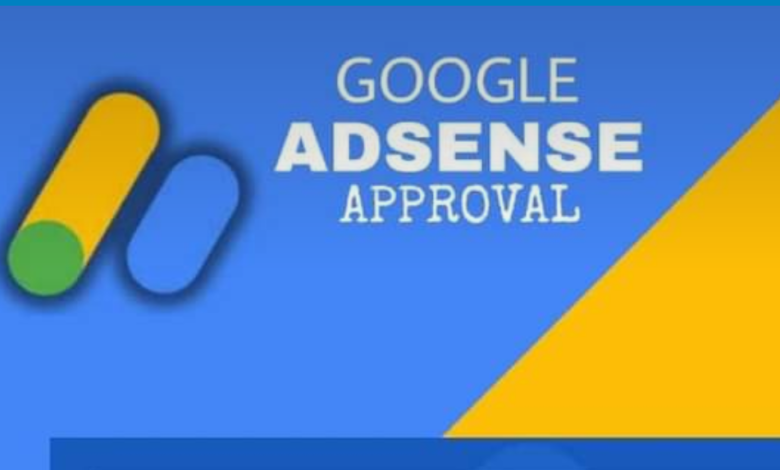Google AdSense Approval: Your Comprehensive Guide to Monetizing Your Website

Google AdSense Approval: Your Comprehensive Guide to Monetizing Your Website
Introduction:
Monetizing your website through Google AdSense can open up a world of opportunities to earn revenue from your online content. However, before you can start enjoying the benefits of ad earnings, you need to navigate the process of getting your Google AdSense account approved. In this SEO blog post, we’ll provide you with an in-depth guide to securing that coveted AdSense approval, covering everything from eligibility criteria to best practices for a successful application.
1. Understand the Eligibility Criteria: Google AdSense has specific criteria that your website must meet to be eligible for approval. These include:
- High-Quality Content: Your website should offer original, valuable, and relevant content to users.
- Website Policies: Ensure your site has a clear and easily accessible privacy policy, terms of use, and other required policies.
- Domain Age: While there’s no strict minimum, having a website that has been live for a few months with consistent content can improve your chances.
- Comply with AdSense Policies: Familiarize yourself with Google’s AdSense Program Policies to avoid violations that could lead to disqualification.
2. Create Valuable Content: High-quality content is the backbone of a successful AdSense application. Focus on creating original and engaging content that resonates with your target audience. Incorporate relevant keywords naturally to improve the visibility of your site on search engines.
3. Optimize Website Design: A clean and user-friendly website design enhances user experience and contributes to your site’s credibility. Ensure your site is easy to navigate, mobile responsive, and loads quickly. Google values websites that prioritize user experience.
4. Build Organic Traffic: Generating organic traffic demonstrates the appeal and relevance of your content. Share your content on social media, engage with your audience, and work on search engine optimization (SEO) to improve your website’s search engine ranking.
5. Ensure Proper Navigation: An organized and intuitive website structure helps both users and search engines understand your content. Use clear menus, categories, and internal linking to guide visitors through your site.
6. Develop a Privacy Policy and About Page: Having a privacy policy and an about page is crucial to demonstrate transparency and build trust with users and advertisers. Your privacy policy outlines how you collect and use user data, while your about page provides information about your website’s purpose and ownership.
7. Avoid Prohibited Content: AdSense has strict guidelines regarding content that is prohibited for monetization. Avoid adult content, copyrighted material, violent content, hate speech, and any other content that violates AdSense policies.
8. Apply for AdSense: Once you’re confident that your website aligns with AdSense’s eligibility criteria, apply for an AdSense account. Visit the AdSense website, provide the required information, and submit your application. Google will review your site to ensure it meets their standards.
9. Be Patient: The review process can take some time. Be patient and continue to focus on creating valuable content and growing your website’s traffic while waiting for approval.
10. Monitor Your Application Status: You can track your application status through the AdSense dashboard. Once your application is approved, you’ll receive an email notification with instructions on how to integrate AdSense ads into your site.
Demystifying Google AdSense Approval: Understanding Eligibility Criteria
Monetizing your website with Google AdSense can be a rewarding venture, but the path to approval requires a clear understanding of the eligibility criteria set by Google. AdSense ensures that only websites that meet certain standards are allowed to participate in their advertising program. In this blog post, we’ll delve into the key eligibility criteria you need to know before applying for Google AdSense approval.
1. High-Quality Content: Quality content is the cornerstone of a successful website and an essential criterion for AdSense approval. Your content should be original, valuable, and relevant to your target audience. It’s not just about quantity, but also about delivering information, entertainment, or solutions that engage your visitors.
2. Website Policies: AdSense requires websites to have certain policies in place to ensure transparency and user trust. These policies include a privacy policy, terms of use, and any other necessary legal disclaimers. Make sure these policies are easily accessible to users, often linked in the website footer.
3. Domain Age and Ownership: While there’s no strict minimum domain age requirement for AdSense approval, having a website that has been live for a few months can demonstrate your commitment to maintaining a consistent online presence. Also, you should be the rightful owner of the domain and have control over its content.
4. AdSense Policies Compliance: AdSense has a comprehensive set of policies that cover content, behavior, ad placement, and more. Your website must adhere to these policies to ensure a safe and respectful online environment. Violations of these policies could lead to disqualification from the program.
5. Website Niche and Language: While AdSense is quite flexible when it comes to the niche or topic of your website, certain niches like adult content, gambling, and illegal activities are prohibited. Additionally, your content should be in a language that AdSense supports.
6. User Experience: Google values user experience, so your website should be well-designed, easy to navigate, and mobile responsive. A positive user experience not only enhances your chances of AdSense approval but also benefits your website’s overall engagement and SEO.
7. Traffic Source and Origin: While there’s no minimum traffic requirement, having organic and genuine traffic sources is essential. Avoid using methods that artificially inflate your traffic, as Google values real user engagement.
8. Content Ownership: Ensure that all the content on your website, including text, images, and multimedia, is original and not copied from other sources without proper attribution. Plagiarized content can lead to rejection.
9. Site Structure and Navigation: Your website should have a clear and organized structure that makes it easy for users to find what they’re looking for. Use categories, menus, and internal links to guide visitors through your content.
Crafting Valuable Content: Your Path to Google AdSense Approval
In the digital realm, content is king. Creating valuable, informative, and engaging content isn’t just essential for attracting and retaining visitors; it’s also a critical factor in securing Google AdSense approval. In this blog post, we’ll delve into the art of crafting content that not only resonates with your audience but also meets the standards required for a successful AdSense application.
1. Understand Your Audience: Before you start creating content, take the time to understand your target audience. What are their interests, needs, and pain points? Tailoring your content to address these aspects will make it more valuable and relevant.
2. Provide Solutions: Valuable content often addresses problems, questions, or challenges that your audience faces. Offer solutions, insights, and practical advice that can genuinely help your readers. This positions your website as a reliable source of information.
3. Originality Matters: Google values original content. Avoid duplicating or copying content from other sources without proper attribution. Your content should bring a fresh perspective or unique insights to the table.
4. Thorough Research: Whether you’re writing an informative article, a how-to guide, or an opinion piece, thorough research is key. Back up your statements with credible sources, data, and examples to establish your authority in the subject matter.
5. Engaging Writing Style: A captivating writing style keeps readers hooked. Use anecdotes, stories, and relatable examples to make your content more engaging. Write in a conversational tone that resonates with your target audience.
6. Visual Enhancements: Incorporate visual elements such as images, infographics, and videos to complement your written content. Visuals break up text and make your content more appealing and easier to understand.
7. SEO-Friendly Content: Optimize your content for search engines by using relevant keywords naturally. This helps your content rank higher on search engine results pages, making it more discoverable to your target audience.
8. Long-Form Content: While shorter articles have their place, long-form content often provides more in-depth value. It allows you to delve into topics comprehensively, demonstrating your expertise and authority.
9. User-Focused Structure: Organize your content with a clear structure that guides readers through the information. Use headings, subheadings, bullet points, and paragraphs to break up content and make it easy to scan.
10. Continual Improvement: Regularly update and refresh your content to keep it relevant. This shows that you’re committed to providing accurate and up-to-date information to your audience.
Elevating User Experience: Optimizing Website Design for Google AdSense Approval
In the digital landscape, a well-optimized website design isn’t just visually appealing; it’s a key factor in attracting and retaining visitors. When it comes to Google AdSense approval, an optimized design is essential to provide a seamless user experience and create a favorable impression on both users and Google’s review team. In this blog post, we’ll explore strategies to enhance your website’s design to meet the standards required for a successful AdSense application.
1. Clean and Intuitive Layout: A cluttered layout can overwhelm visitors and deter them from engaging with your content. Opt for a clean and intuitive layout that guides users through your website effortlessly. Use a consistent color scheme, readable fonts, and appropriate spacing to create a visually appealing experience.
2. Mobile Responsiveness: With the majority of users accessing websites via mobile devices, mobile responsiveness is crucial. Your website should adapt seamlessly to various screen sizes, ensuring a user-friendly experience on smartphones and tablets.
3. Fast Loading Speed: Slow-loading websites lead to higher bounce rates and frustrated users. Optimize your website’s images, scripts, and code to ensure fast loading times. This not only improves user experience but also aligns with Google’s preference for well-performing sites.
4. Intuitive Navigation: Navigation should be straightforward and intuitive. Use clear menus, categories, and internal links to help users find what they’re looking for quickly. A well-organized navigation structure contributes to a positive user experience.
5. Strategic Ad Placement: While preparing for AdSense, plan your ad placements strategically. Avoid overwhelming your content with ads; instead, integrate them seamlessly into your design. Ad placements should enhance, not disrupt, the user experience.
6. Avoid Pop-up Overload: Excessive pop-ups can annoy users and lead to a poor browsing experience. If you use pop-ups, ensure they are relevant, non-intrusive, and do not hinder user engagement.
7. Consistent Branding: Your website’s design should reflect your branding consistently. Use your logo, color palette, and visual elements that resonate with your brand identity. A consistent brand presence fosters trust and recognition among visitors.
8. Readability and Accessibility: Your content should be easily readable, especially on different devices. Use legible fonts and appropriate font sizes. Additionally, ensure that your design adheres to accessibility guidelines, making it usable for all visitors, including those with disabilities.
9. Minimalistic Approach: Simplicity often leads to better user engagement. Adopt a minimalistic design approach by removing unnecessary elements and focusing on what truly matters—your content and its presentation.
10. Test and Iterate: Regularly test your website’s design across different devices and browsers. Gather feedback from users to identify areas that could be improved. Continual refinement ensures that your design remains effective and user-friendly.
Building Organic Traffic: The Road to Google AdSense Approval and Beyond
In the dynamic realm of online content, driving organic traffic to your website is the cornerstone of success. When it comes to Google AdSense approval, a robust flow of organic traffic not only demonstrates the value of your content but also positions your website for a fruitful partnership. In this blog post, we’ll explore effective strategies to boost organic traffic, enhancing your chances of AdSense approval and creating a solid foundation for sustained growth.
1. High-Quality Content Creation: Creating valuable, informative, and engaging content is the bedrock of attracting organic traffic. Craft content that answers questions, provides solutions, or entertains your target audience. Quality content naturally encourages visitors to share and recommend your site, increasing its visibility.
2. Keyword Research and Optimization: Keyword research helps you understand what your audience is searching for. Integrate relevant keywords naturally into your content to improve your website’s visibility on search engine results pages (SERPs). Long-tail keywords can be particularly effective in capturing specific search intents.
3. On-Page SEO: Optimize your web pages for search engines by using descriptive meta titles, meta descriptions, and header tags. A well-structured page with relevant keywords makes it easier for search engines to understand and rank your content.
4. Content Consistency: Consistency is key to building organic traffic. Publish new content regularly, whether it’s blog posts, articles, videos, or other formats. This not only keeps your audience engaged but also signals to search engines that your website is active and relevant.
5. Internal and External Linking: Utilize internal linking to guide visitors to related content within your website. External linking to reputable sources also enhances your content’s credibility and authority.
6. Social Media Engagement: Share your content on social media platforms to reach a wider audience. Engage with your followers, respond to comments, and encourage sharing to amplify your content’s reach.
7. Guest Blogging and Collaborations: Contribute guest posts to relevant websites in your niche. This not only exposes your content to a new audience but also builds valuable backlinks that can improve your site’s search engine ranking.
8. Email Marketing: Build an email list and send regular newsletters containing your latest content. This direct communication channel keeps your audience informed and engaged.
9. Influencer Partnerships: Collaborate with influencers or experts in your niche. Their endorsement can introduce your website to a wider audience, driving traffic and enhancing your website’s credibility.
10. Optimize for User Experience: A user-friendly website design and seamless navigation enhance user experience, encouraging visitors to explore more pages and spend more time on your site. This can have a positive impact on your website’s search engine ranking.
Navigating Success: The Importance of Proper Website Navigation for Google AdSense Approval
In the vast expanse of the digital landscape, a website’s navigation plays a pivotal role in determining its success. Beyond aesthetics, seamless navigation is a critical factor in obtaining Google AdSense approval and providing a positive user experience. In this blog post, we’ll delve into the significance of proper website navigation, its impact on AdSense approval, and strategies to ensure visitors can navigate your site with ease.
1. User-Friendly Experience: An intuitive navigation structure enhances user experience, enabling visitors to find the information they seek effortlessly. When reviewing AdSense applications, Google evaluates websites for their user-friendliness, making proper navigation a fundamental aspect of approval.
2. Clear Menu and Categories: Design a clear and organized menu that highlights key sections of your website. Use concise labels that accurately represent the content within each category. Visitors should be able to quickly identify where they can find the information they need.
3. Consistent Layout: Maintain a consistent layout across all pages. Keep the placement of navigation elements, such as the menu and search bar, consistent so that users can easily locate them regardless of the page they’re on.
4. Breadcrumb Trails: Implement breadcrumb trails to show users the path they’ve taken to reach a particular page. Breadcrumbs provide context and help users navigate back to previous sections without losing their way.
5. Internal Linking: Strategically use internal links within your content to guide users to related articles or pages. This not only aids navigation but also encourages users to explore more of your content, increasing engagement.
6. Mobile Responsiveness: In the age of mobile browsing, ensure your navigation works seamlessly on all devices. Mobile users should have the same intuitive experience as desktop users, enhancing their engagement and satisfaction.
7. Minimize Clicks to Important Pages: Critical pages, such as your homepage or key content sections, should be accessible within a minimal number of clicks. This reduces user frustration and increases the likelihood of visitors engaging with your content.
8. Search Functionality: Incorporate a search bar that enables users to quickly find specific content. A well-implemented search function can be a lifesaver for users seeking information efficiently.
9. Test and Gather Feedback: Regularly test your website’s navigation to identify any issues or challenges users may encounter. Solicit feedback from users to understand their navigation preferences and pain points.
10. Continuous Improvement: Website navigation is not a one-time task; it’s an ongoing process. Continuously monitor user behavior and adapt your navigation strategy based on their preferences and needs.







